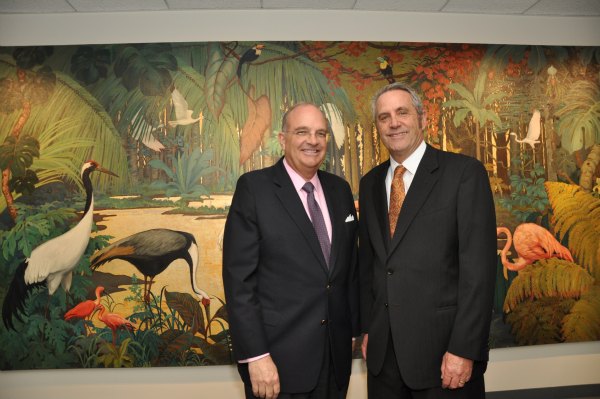
Last Thursday evening, I had the pleasure of attending a special reception hosted by First Foundation Bank at the Irvine Museum featuring museum President James Irvine Swinden, who gave us a first-hand look at some of California’s most beautiful and important works of art, along with some of the fascinating history behind each on exhibit in the museum.
As he guided us through the spellbinding world of such greats as William Wendt, Donna Schuster and Joseph Kleitsch hung throughout the museum’s galleries, Irvine Swinden deftly transported us back to the early days of California, captured in paintings like “Laguna Eucalyptus” painted by Guy Rose in 1918; and “Cannery Row, Newport Beach” painted in 1926 by George Brandiff. It was like stepping back in time to view California back in the days when Lido Island was still just a sand bar.
I could tell everyone in the room was inspired. But many were there for another reason besides a deep admiration for regional plein air art. As I found out as we moved on to enjoy the social part of the reception, many were there to learn about a new trend in wealth management that leverages art collections in to tax advantaged 1031 Exchanges so that collectors can diversify their collections. Clients also receive advice on passing their collections on to future generations of family, charities or museums.
Not exactly being a financial whiz, this is the part of the evening where I was cast back from the willowy haze of artistic admiration to real-world reality. Luckily, as we munched on delicious gourmet finger food, First Foundation Bank President, Dave Rahn, got up to address the crowd, explaining the unique investment concept as only an artist could – and it turns out, in addition to being the president and chief operation officer, he actually is a bonafide plein air artist himself.
The affable Lido Island resident joked as he casually stood before the intimate group, “I am a banker by profession, but an artist at heart,” said Rahn. “At least until someone bids up my paintings to the point where I can support my family by selling them.”
Rahn explained that art can and should in certain circumstances be considered a performing investment, part of the diversity that many seek in their investment portfolios.
“Things are really happening in the art world,” Rahn said. “It provides a tremendous educational opportunity for our clients who may or may not know the value of their art collection, or how they can put their art to work. We also help our clients understand how best to preserve their collection in perpetuity if that is what they desire.”
In the current economic atmosphere that some refer to as a “Goldilocks economy”, where things are not too cold, not too hot…. fine art seems to stand the test of time.
I had no idea that in the world of investing, art is a category all its own. Many people simply have no idea what their collection is worth and when they find out, it’s like finding buried treasure hanging over the sofa in the den. Think of “Antiques Roadshow” – when great-grandma’s hand-me-down actually turns out to be worth $200K – and you get the idea.
The event at the Irvine Museum was a good example of an ongoing series of similar events that First Foundation Bank is hosting featuring private showings at a range of museums and private homes for prospective clients.
Lynn Selich can be reached at www.LynnSelich.blogspot.com.




